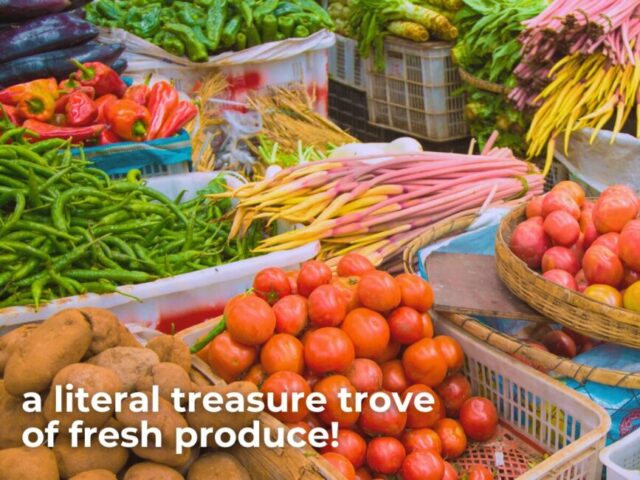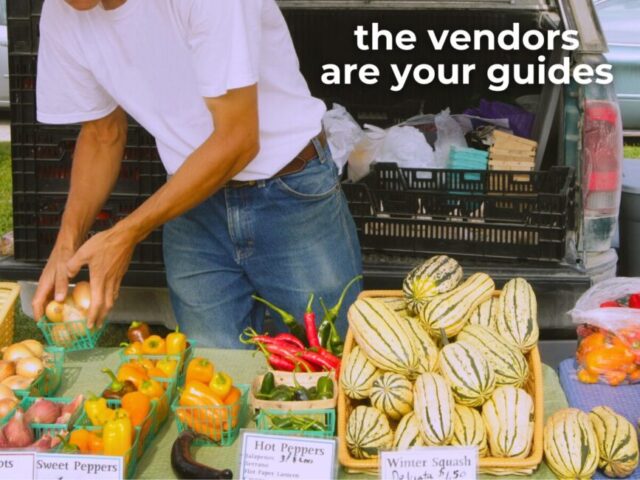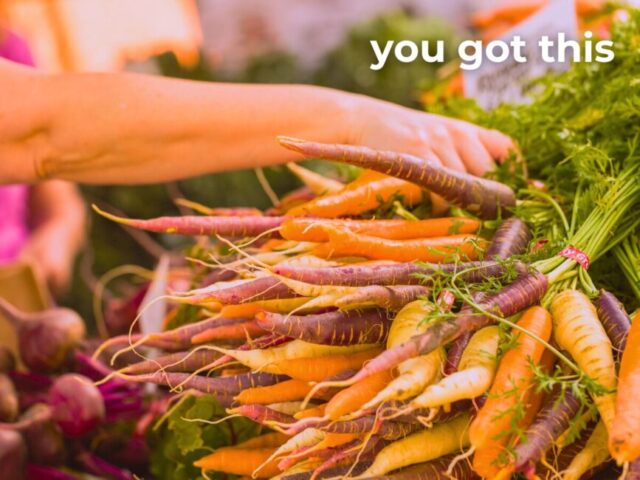Spring is here and it’s prime time to check out your local farmers’ market! Sure, grocery stores are great (hello, midnight ice cream runs), but when you’re looking for uber fresh produce with a little community spirit on the side, then the farmers’ market is where you wanna be.
This spring, I’m gonna let you in on some farmers’ market tips and tricks to make your visit the best it can be, and maybe help you save some money along the way. But first, let’s talk about some reasons why you should take advantage of the market vibes this time of year.
Why You Should Beeline to the Farmers’ Market This Spring

You Get the Freshest of the Fresh: Your local farmers’ market is kinda like the VIP section of the food world. It’s a paradise of fresh fruits and heirloom tomatoes that rival anything you might find at the grocery store. And spring is when farmers’ markets really start to buzz with everything from leafy greens to the first strawberries of the season. It’s usually the best time of year to visit because it provides you access to the freshest produce possible.
You Can Support Your Local Economy: You can feel good shopping at farmers’ markets it because not only do you go home with a tote brimming with goodies, but you also get to nourish your local economy and support small farmers and local businesses.
You Can Connect with Local Farmers & Vendors: Everyone loves getting the best produce at the best prices, but another perk of market trips is that they’re a great way to connect with food vendors and local farmers, and these relationships can lead to amazing deals on high-quality food and produce.
It’s a Great Place to Try New Things: Always been curious certain produce, but never had the nerve to try it? This is the place to experiment! Not only do you have the professionals in front of you to ask all the questions you want, but you can be confident that fruit or veggie is at its freshest!
The Vendors Are Your Guides: Looking for information on peak seasons for your favorite fruits and veggies? Or maybe you’re not sure how to store those leafy greens? Your friendly local farmers market vendor is there to guide you!
What to Look for at Your Local Farmers’ Market

Here’s a list of some common in-season spring produce you might find at your local farmers’ market:
1. Asparagus – A staple of early spring, asparagus makes a great pairing to almost any dinner. I like to wrap them in prosciutto, spray them with oil, add some salt and pepper, and air fry them for 10 minutes. But you can also grill, steam, or stir-fry them to bring out their natural sweetness.
2. Radishes – Radishes make for a great peppery addition to salads and add a little crunch. And did you know that you don’t have to discard the greens? They’re delicious sautéed or even added to soups!
3. Spring Onions – Scallions, green onions, spring onions. Whatever you call them, they’re a lot milder than mature onions and do great in salads, salsas, or as a topping to grilled fish or steak.
4. Peas – Snap peas. Snow peas. Garden peas. Your local farmers market may have them all! And they’re sweetest when freshly picked. Toss them into pastas and risottos for a healthy addition with a little texture.
5. Spinach – This extremely nutritious and versatile leafy green goes soft in warm dishes but stays crisp in cool salads, so it’s a great addition to whatever you might feel like for lunch or dinner.
6. Lettuce and Salad Greens – Spring is known for its introduction to flavorful greens, from butterhead to arugula, and the farmers’ market is a veritable cornucopia of all the greens you could ever need.
7. Strawberries – Strawberries are the superstar of springtime, and if you get them at a farmers’ market, they’re often far juicier and sweeter than what you would find in grocery stores. They’re also great for desserts, spring salads, by themselves, or dipped in honey or Nutella.
8. Rhubarb – If you’re looking to make some pies or jams, rhubarb is your best friend because its tartness generally balances out the sweetness of any fruits you might be using.
9. Artichokes – Though they take a little extra doin’, artichokes are a spring delicacy that you can enjoy steamed or grilled. Use the hearts in dips or in pasta dishes.
10. Baby Potatoes – Young potatoes are smaller and less starchy than full-grown potatoes, and their skins are so tender, you don’t have to peel them! Baby potatoes are great roasted with herbs or cut and popped into your slow cooker with steak for stew or as a side dish.
11. Herbs – Fresh herbs practically scream springtime, and your farmers’ market likely has them cut and planted. If you’ve been thinking of starting an herb garden, this is the best time of year to do it. Look for popular herbs like fresh basil, mint, and cilantro.
Tips for Mastering Your Farmers’ Market Visit

1. Create a Game Plan
Every successful farmers’ market visit starts with a plan. Why? Because it’s easy to go a little stir-crazy among the sea of produce and sweet treats, especially if it’s your first time there. Creating an idea of what food items you’re looking for will help keep you on track and away from going over budget.
2. Don’t Overbuy
Here’s the golden rule of farmers’ markets: Think about your upcoming meals for the next week. It’s all too common to get overly excited and buy way more than you can eat at your local market, and then have to throw away a bunch of perishable items that have gone bad before you even got the chance to eat them. Having a plan not only saves you time and money, but also prevents the heartbreak of food waste.
3. Cash is King
Debit and credit cards are great for supermarket shopping, but at farmers’ markets, old-fashioned cash is often the easiest way to pay. Small farms and food vendors usually prefer cash to avoid paying ridiculously high credit card fees, and sometimes that means they pass the savings onto you with a better price for produce. In fact, some may not accept cards at all, so be sure to bring smaller bills and change for the smoothest transaction experience. It’ll also help you stick to your budget!
4. Bring Reusable Bags
The farmers’ market is all about sustainability. In the spirit of being eco-friendly, be sure to bring your own reusable bags to reduce the demand for non-biodegradable plastic bags. Plus, vendors will appreciate you saving them materials. At the end of the day, you’ll feel good that you helped boost your local community’s economy in an eco-friendly way by bringing your own bag.

5. Ask All The Questions
A vendor is more than just a provider of produce. They are also your seasonal food guide! And one of the best tips for making the most of your farmers’ market visit is: engage with vendors. Unsure what the heck that curly-topped veggie is? Don’t know if those peaches are sweet enough for tonight’s dessert? Not sure what the best way to store something is? Ask! Farmers’ markets are a great opportunity to learn all you need to know directly from the source. (When else do you get to do that with your food?) And farmers are usually more than eager to talk about the best way to store and prepare the produce they sell.
6. Know What’s in Season
Whatever season you’re visiting your local market, it’s a good idea to go in with an understanding of what’s in season. Obviously, this will help you to know what you can expect to be available there, but more importantly, you’ll know what is unlikely to be found there. And this is a good indicator of whether or not a vendor is selling produce that they grew themselves or simply buying from big name stores and reselling at a markup. When vendors sell produce that is out of season in your local area, you can be sure they bought it outside of your local area. Watch out for produce that still has tags or is stored in big name boxes like Dole. Having this knowledge will ensure you’re truly supporting local producers and getting the best quality seasonal produce from your own neck of the woods.
7. Peek Under Your Produce Boxes
Have you ever picked up a box of beautiful strawberries only to discover the last layer was moldy mush or a bruised mess? Here’s a simple but important market tip: always look under the bottom of your produce boxes. While local vendors pride themselves on quality, sometimes the hustle and bustle of setting up at a farmer’s market can result in a few rotting stragglers sneaking into the bottom of the pile. Give those potential purchases a quick lift to make sure the pretty tops are not hiding a gross secret underneath. That being said, don’t write off ugly fresh produce! Some of the best tasting fruits and veggies might look a little unconventional, and sometimes vendors give great deals on produce that isn’t picture perfect.
8. Farmers’ Markets & SNAP Benefits
Did you know that outdoor markets benefit low-income communities? For those on food assistance programs like SNAP (Supplemental Nutrition Assistance Program), many farmers’ markets across the United States are not only SNAP-friendly, but they usually offer incentive programs that DOUBLE the value of food stamps! This means every dollar of SNAP spent at the market could be worth two, making everything essentially half price.
9. See It All Before You Buy
When you first arrive at your local farmers’ market, you might be drawn in and tempted to buy fruits and items on the spot, but you should resist the urge to dive right into buying from the first stand you see. Unless something is in limited quantity, try to take a stroll through the entire market to check out all of their offerings before you purchase anything. This strategy will help you find the best deals by comparing prices on similar products while also keeping you on budget. Vendors of similar items price their goods differently, especially when it comes to common items like leafy greens or fresh meats. A complete lap means the difference between a good deal and a great one.
10. Always Wash Your Produce
Last but certainly not least, once you bring home your market haul, always be sure wash your produce before you eat it. The produce that farmers carry generally comes straight from the field and can carry dirt, bacteria, pesticides, or even small insects on (or in) it. Washing your fruits and vegetables under running water helps reduce the risk of foodborne illness and promotes the best food safety possible. For berries, I like to soak them in a bath of 1 part vinegar and 4 parts water for 4 minutes before I store them in my crisper. (Don’t soak them too long or they will get mushy.)
Now You’re a Farmers’ Market Pro!

I hope this guide helped you feel confident about your farmers’ market journey, whether you’re a seasoned pro or it’s your first time. There truly is nothing like the experience of walking a local market, discovering new foods, interacting with members of your community, supporting local farmers, and then bringing your haul home and enjoying all that fresh, hand-selected produce.
Here’s one extra tip: If you’re on social media, check out the market’s social media account before your next trip. They’re usually a great resource for updates on new vendors or special events.
Do you frequent farmers’ markets? What’s your favorite thing about them? What are some of the best deals you’ve come across? Have you ever picked up something you’ve never tried at your local market and loved it? We love hearing all about your experiences, so be sure to leave us a comment!
Happy eating, and we’ll see you at the market!
The post The Top 10 Tips for Shopping Spring Farmers’ Markets appeared first on Steamy Kitchen Recipes Giveaways.
from Steamy Kitchen Recipes Giveaways https://ift.tt/b5ykWap
via New Kitchen Special
No comments:
Post a Comment